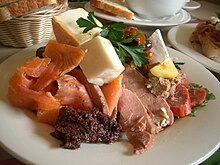Antipasto
This articleneeds additional citations forverification.(March 2024) |
 Antipasti served in a restaurant | |
| Place of origin | Italy |
|---|---|
| Main ingredients | Any ofcured meats,olives,peperoncini,mushrooms,anchovies,artichokehearts,cheese,pickled meatsand vegetables (in oil or vinegar) |
| Variations | Seafood platter;calamari,mussels, smoked salmon, tuna fish, olives |

Antipasto(pl.:antipasti) is the traditional first course of a formalItalian meal.[1]Usually made of bite-size small portions and served on a platter from which everyone serves themselves, the purpose of antipasti is to stimulate the appetite.[2]Typical ingredients of a traditional antipasto includescured meats,olives,peperoncini,mushrooms,anchovies,artichokehearts, variouscheeses(such asprovoloneormozzarella), pickled meats, and vegetables in oil or vinegar.
The contents of an antipasto vary greatly according to regional cuisine. Different preparations of saltwater fish and traditional southern cured meats (likesoppressataor'nduja) are popular in thesouth of Italy,whereas innorthern Italyit is common to serve different kinds of cured meats and mushrooms and, especially near lakes, preparations offreshwater fish.The cheeses included also vary significantly between regions and backgrounds, and include hard and soft cheeses.
Many compare antipasto tohors d'oeuvre,but antipasto is served at the table and signifies the official beginning of the Italian meal. It may also be referred to as a starter, or an appetizer.
See also
[edit]- List of hors d'oeuvre
- List of ancient dishes and foods
- List of Italian dishes
- Italian meal structure
- Cured meat
References
[edit]- ^"Definition of ANTIPASTO".www.merriam-webster.com.
- ^What is Antipasto?
Further reading
[edit]- Scicolone, Michele (1998).The Antipasto Table.HarperCollins.ISBN9780880016278.RetrievedApril 20,2012.
